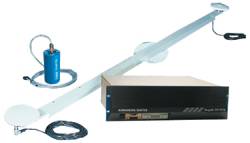Network - Seapath MRU Binary Format 11 (UTC) - 03
Description
Driver to be used to decode roll-pitch-heave, heading and/or lat-lon-height observations from a Kongsberg Seatex Seapath MRU, outputting the Seapath Binary messages, in Standard Format or Format 11.
Notice that if the unit outputs the Simrad EM1000 or EM3000 binary format, you should select driver "Simrad EMx000 R-P-H"

Driver Information
Coding Notes
Decoding Notes
The Seapath MRU driver will reverse the sign of the heave so that +ve heave is up, as is standard in Qinsy. All units are converted to meters and degrees, respectively.
If a status bit for a Seapath observation type (i.e. position, heave, roll-pitch, or heading) is "invalid", then the quality indicator is set to -1.
If a status bit is "reduced" then the quality indicator is set to 0.11.
If a status bit is OK, then the quality indicator is +1.
If the checksum of the message fails, and data is still decoded (parameter "NOCS"), then quality indicator is set to -999.
The driver supports checksum verification for Standard format and Format 11.
System Interfacing
Interfacing Notes
The driver is a so-called passive driver, i.e. it does not send commands or data back to the unit, so only one-way serial cable wiring is needed, using the following wiring diagram:
DB-25 | Seapath unit | or | DB-9 | Seapath unit |
| DB-25 | COM | or | DB-9 | COM |
Pin 2 | TXD | Pin 3 | TXD | ----- | Pin 3 | RXD | Pin 2 | RXD | ||
Pin 3 | RXD | Pin 2 | RXD | X | Pin 2 | TXD | Pin 3 | TXD | ||
Pin 7 | SG | Pin 5 | SG | ----- | Pin 7 | SG | Pin 5 | SG |
Qinsy Config
Database Setup
Position navigation systems
To decode the position (Lat/Lon/Height), add a system of type "Position Navigation System", select the same driver name and the same I/O parameters as for the other systems and define the antenna node and reference datum.
Gyro compass system
To decode the heading, add a system of type "Gyro and Compasses", select the appropriate driver, and define the heading parameters.
Pitch roll heave system
To decode the pitch, roll and heave, add a system of type "Pitch, Roll and Heave sensor" to the Qinsy database and make sure to select the same driver name and the same I/O parameters as for the Gyro system.
Observation | Positive when |
|---|---|
Roll | Port up |
Pitch | Bow up |
Heave | Upwards |
Notice that the driver will reverse the heave sign, see Decoding Notes for more about this.
Underwater sensor
To decode the height as a depth, add a system of type "Underwater Sensor", select the same driver name and the same I/O parameters as for the other systems above.
Add an observation of type "ROV Depth". The driver will automatically reverse the sign of the decoded height, in order to make it a 'depth'.
extra info
Further, if the unit that outputs the Format 11 message is also interfaced to PPS, you may select the driver that includes "(With UTC)" in its name.
The driver will then timestamp the data using the time of the message, instead of time stamping the data when it's received at the I/O comport.
When the decoded PPS time deviates more than 10 seconds from the actual PPS time the message is not decoded. This is done to prevent acceptance of invalid time stamps.
Additional Info
Drivers IO Notes
Command line parameter "11" will decode the "Format 11" data strings (length 42 bytes), otherwise the "Standard" data strings (52 bytes) are expected.
Parameter "NOCS" for both formats will continue decoding the data if the checksum value does not correspond to the actual data; quality is set to -999.
Parameter PPS informs the driver to use the timetag from the message.
